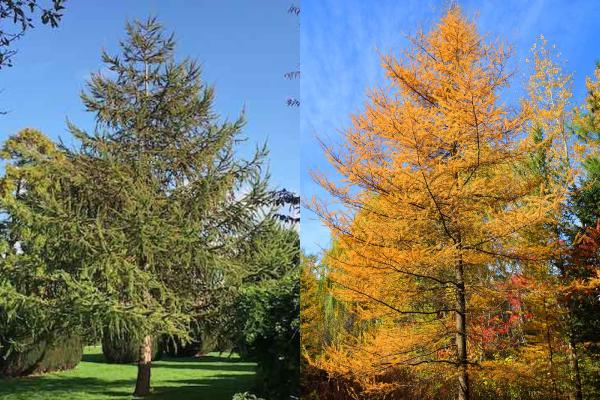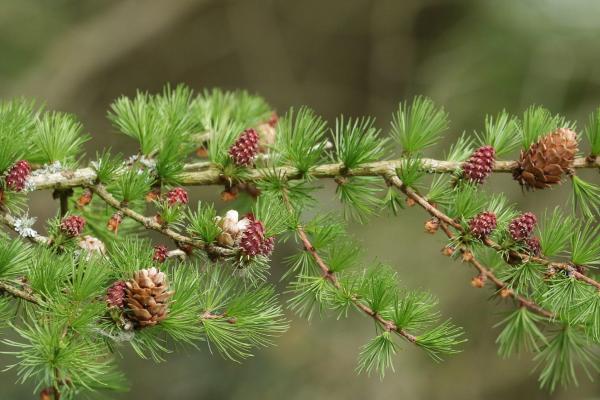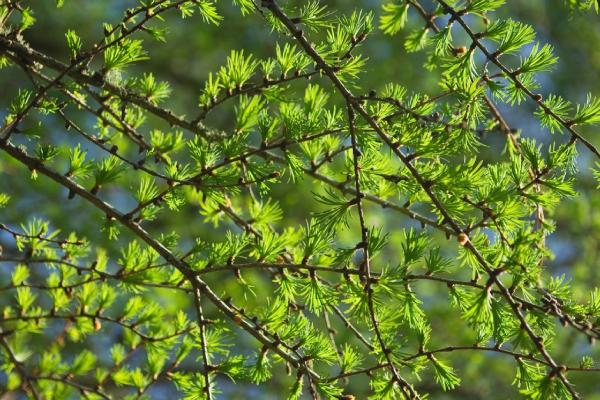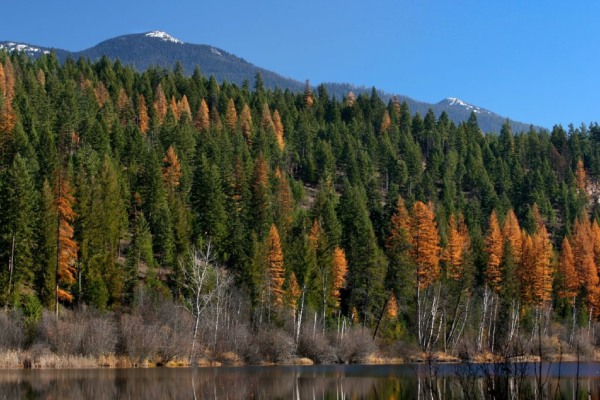Larch is a type of conifer belonging to the genus Larix in the Pinanceae family. It is a medium-sized tree that has the common pyramidal (cone-shaped) canopy typical of conifers. They have short needles, about an inch long, that grow in clusters of 30 to 40 along the stems. During spring and summer, larches look like evergreen trees because they have green needles. Among green needles, you will also find pinkish-red female flowers that later develop into cones. However, larch needles change color in the fall, turning a golden yellow. Whereas during winter, needles started falling off to the ground. Further, the larch tress has thick, light brown bark with some types showing a pink tint beneath the brown. The bark is made of thin layers that easily split apart. Larch also produces fruits that is red or pale yellow cone which turns brown and becomes scaly as the tree grows older.
Here we explain more on how to grow and care for larches.
Plant Description
Plant Type: Tree
Family: Pinaceae
Genus: Larix spp.
Common Name: Larch, Tamaracks
Season: Spring, Fall
Native Areas: Northern Europe, Asia, and North America
Where do Larch trees grow best?
Larch trees grow best in mountainous areas with cool, moist climates. The best time to plant larch is during the dormant season, from November to March. During this period, the trees are not actively growing which helps them establish roots more effectively. When planting and caring for a larch, it is important to choose the right location and consider the environmental conditions. Plant a larch in a wild or woodland garden where it has plenty of space to grow. Water the tree during long dry spells for the first two years to help it establish. Similarly, larch trees are beneficial for wildlife, providing food for birds and mammals with their cones and offering shelter to insects in their bark. Some moth caterpillars also feed on larch foliage.

Types of Larch
Larch is mainly divided into two groups, North American species and Eurasian species. The Eurasian group is further split into two categories based on the length of the bracts. In this division, the larch species found in northern regions have shorter bracts, while those in southern regions have longer bracts. According to the most recent genetic research, there are ten different species of larch, some of which are mentioned below:
European Larch
European Larch, a tree scientifically known as Larix decidua, is popular for its beautiful autumn colors when its needles turn bright gold. It belongs to the northern short-bracted species and can grow up to 100 feet tall and 30 feet wide. It thrives in hardiness zones 2-6 and is a shade-intolerant species commonly found in the Carpathian Mountains and the Alps. Due to its beautiful appearance, the European Larch is popular for enhancing gardens and parks.
Eastern Larch or Tamarack
Eastern Larch or Tamarack, scientifically known as Larix laricina, is a type of larch tree that naturally grows in North America, especially in colder regions. The tree is known for its striking colors, particularly in the fall when its bright green needles change to a golden hue before shedding. The Tamarack can grow to about 75 feet tall and 30 feet wide. It thrives in hardiness zones 2-5, making it well-suited for cold climates.
Western Larch
Western larch is a type of large deciduous conifer found in western North America and parts of Canada and the United States. This tree can grow up to 150 feet tall and has needles that are less than 2 inches long. Its needles grow in bundles like those of a pine tree. The needles are a soft green color when they grow new and change to a golden yellow in the fall before they drop off. This tree is special because it is one of the few conifers that lose their needles in winter, leaving behind bare branches with noticeable spur twigs. The cones of the Western larch look similar to those of the mountain hemlock, but they have unique whisker-like bracts that stick out beyond the scales. Further, the bark of the tree is made up of gray or brown flaky plates, which become furrowed as the tree ages.

How to take care of Larch
Light
Larches, like most coniferous trees, thrive best in full sunlight. Plant the tree in a location where it will receive a minimum of six hours of direct sunlight each day.
Soil Preparation
Larch trees prefer moist or boggy soil with a pH between 5.0 and 7.4. The soil must also be acidic and abundant in organic matter, similar to their natural habitat.
Water
If the location where you plant the trees tends to be naturally dry, make sure to water the tree frequently to keep the soil consistently moist. Furthermore, consider applying mulch such as chipped bark around the tree’s root. This will help retain moisture in the soil and provide protection to the roots.
Temperature and Humidity
Larch thrives in higher altitudes where their canopies can grow without any restrictions. These trees are hardy and well-suited to USDA Zones 2 through 6. However, if you live in a climate that is hot and humid, it is not an ideal environment for planting a larch tree.
Fertilizer
Planting a larch tree in soil rich in organic matter typically means you don’t need to add fertilizer. However, if you want, you may spread a thin layer of compost around the tree each spring. Make sure to avoid fertilizing during the first two years as it can harm the young tree.
Pruning
Generally, pruning is not required for larch trees except to remove dead or damaged branches as soon as you notice them. If you wish to shape the tree or control its size, it is best to prune during the sinter while the tree is in its dormant period.
Pests and Disease
Larch is affected by several pests such as larch bark beetle, larch casebearer, and larch sawfly. These pests can damage the needles and cause defoliation so, it is important to prevent this before it spreads all over trees. The tree can also be infected by the most serious disease called Phytophthora ramorum, which also infects trees like oak. This disease causes needle shedding, making the tree look sparse and unhealthy, and can lead to bleeding cankers on the trunk. Further, Larch trees are sensitive to air pollution, which can discolor needles and stunt growth.
Conclusion
In conclusion, the larch is such a wonder to tree with its seasonality and variation in species, hence it would be an interesting sight in many landscapes. It has a cone-shaped crown and short clusters of needles, along with golden-yellow foliage in autumn. They do very well in cool, moist climates and mountainous regions. Care in planting involves watching the amount of sunlight, soil moisture, and temperature. By understanding the specific needs of various larch species, such as regular watering, suitable soil, and minimal pruning, gardeners can witness the breathtaking beauty and ecological benefits of these trees. Because of its hardiness in terms of weather conditions, the larch may be prone to infestation by insects and other diseases. Therefore, close monitoring can keep them healthy and resilient. Whether they are to complement a garden landscape or to provide for a home for wildlife, larches are a good addition to a tree enthusiast.

Also read, Top 12 Popular Types of Magnolia Trees and Shrubs!
Frequently Asked Questions
1. What is a larch tree?
A larch tree is a type of conifer belonging to the genus Larix in the Pinanceae family. It is a medium-sized tree that has the common pyramidal (cone-shaped) canopy typical of conifers. Similarly, these trees have short needles that grow in clusters and display seasonal color changes from green in spring and summer to golden yellow in fall, before shedding in winter.
2. How tall do larch trees grow?
The larch tree is a moderately fast-growing species. Typically, they can grow about 30 meters tall and spread of between 5 to 8 meters.
3. Can larch trees tolerate drought conditions?
While larch trees prefer moist soil, they are relatively drought-tolerant once established. However, during prolonged dry periods, it is important to water the tree regularly to keep the soil consistently moist.
4. How do larch trees benefit wildlife?
Larch trees provide valuable habitat and food for wildlife. Their cones offer food for birds and mammals, while insects may find shelter in the tree’s bark. Additionally, moth caterpillars feed on larch foliage.
5. Can larch trees be grown in containers?
Larch trees are best suited for planting in the ground due to their size and growth requirements. However, young larch trees can be grown in large containers for a few years. Ensure the container has adequate drainage, and be prepared to repot the tree into a larger container or plant it in the ground as it grows.
